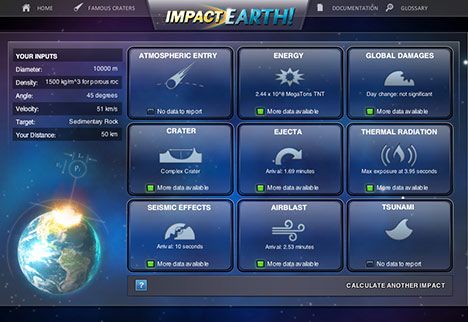That’s right! The meteor impacts and craters described in ASTEROIDS were created with an asteroid impact simulator called Impact:Earth! developed by Purdue University.

Purdue’s Impact:Earth! lets users input parameters such as the asteroids diameter, density, impact angle, impact velocity and the composition of the impact location then generate the results.
I used Impact: Earth! to create several of the impact craters in ASTEROIDS.
You can visit Impact:Earth! to create your own Earth destructing asteroid impact.
Below are the results of the meteor impact I used for the destruction of downtown Perth, Australia.
Earth Impact Effects Program
Robert Marcus, H. Jay Melosh, and Gareth Collins
Please note: the results below are estimates based on current (limited) understanding of the impact process and come with large uncertainties; they should be used with caution, particularly in the case of peculiar input parameters. All values are given to three significant figures but this does not reflect the precision of the estimate. For more information about the uncertainty associated with our calculations and a full discussion of this program, please refer to this article
Your Inputs:
Distance from Impact: 1000.00 meters ( = 3280.00 feet ) Projectile diameter: 80.00 meters ( = 262.00 feet ) Projectile Density: 8000 kg/m3 Impact Velocity: 45.00 km per second ( = 27.90 miles per second ) Impact Angle: 60 degrees Target Density: 2750 kg/m3 Target Type: Crystalline Rock
Energy:
Energy before atmospheric entry: 2.17 x 1018 Joules = 5.19 x 102 MegaTons TNTThe average interval between impacts of this size somewhere on Earth during the last 4 billion years is 1.4 x 104years
Major Global Changes:
The Earth is not strongly disturbed by the impact and loses negligible mass.The impact does not make a noticeable change in the tilt of Earth’s axis (< 5 hundreths of a degree).The impact does not shift the Earth’s orbit noticeably.
Atmospheric Entry:
The projectile begins to breakup at an altitude of 29800 meters = 97600 ftThe projectile reaches the ground in a broken condition. The mass of projectile strikes the surface at velocity 40.2 km/s = 25 miles/sThe impact energy is 1.73 x 1018 Joules = 4.14 x 102MegaTons.The broken projectile fragments strike the ground in an ellipse of dimension 0.299 km by 0.259 km
Crater Dimensions:
What does this mean?
Crater shape is normal in spite of atmospheric crushing; fragments are not significantly dispersed.
Transient Crater Diameter:
3.1 km ( = 1.92 miles )Transient Crater Depth: 1.09 km ( = 0.68 miles )
Final Crater Diameter:
3.61 km ( = 2.24 miles )Final Crater Depth: 435 meters ( = 1430 feet ) The crater formed is a complex crater.
The volume of the target melted or vaporized is 0.0133 km3 = 0.0032 miles3
Roughly half the melt remains in the crater
Ejecta:
What does this mean?
Your position was inside the transient crater and ejected upon impact
